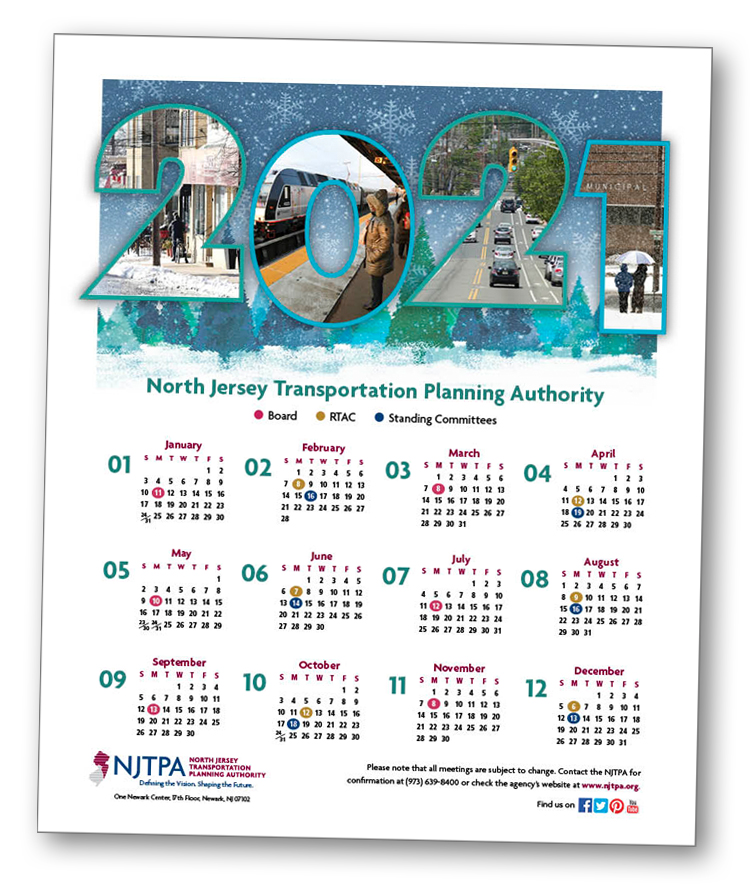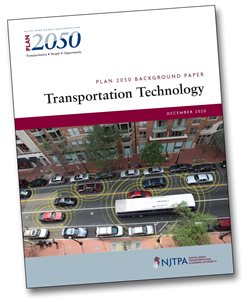December 2020
Posted: 12/15/2020 3:37:15 PM
Download a copy of the calender here.

Posted: 12/15/2020 12:15:30 PM
 Longstanding inequities in transportation systems and related investments will be challenging to overcome. But doing so is critical to support more inclusive communities, better transportation access, improved health, and more economic and social opportunities for everyone, according to experts who spoke at the NJTPA’s December 8 symposium on Advancing Equitable Transportation Systems.
Longstanding inequities in transportation systems and related investments will be challenging to overcome. But doing so is critical to support more inclusive communities, better transportation access, improved health, and more economic and social opportunities for everyone, according to experts who spoke at the NJTPA’s December 8 symposium on Advancing Equitable Transportation Systems.
The virtual program was the second in a series of “TPA Tuesdays” events looking in-depth at critical issues and gathering input for Plan 2050: Transportation, People, Opportunity, the NJTPA’s next Long Range Transportation Plan, scheduled for adoption in fall 2021.
“This current health crisis will pass; however, the need for transportation will not and the realities of climate change mean the need for transportation resiliency and redundancy will only increase,” said Passaic County Freeholder John W. Bartlett, NJTPA First Vice Chair, in his opening remarks. “I’d suggest that as one of the nation’s largest MPOs—in one of the country’s most diverse regions—the NJTPA can lead by example by looking at race and equity issues not solely as obstacles, but also as opportunities.”
Keynote speaker Stephanie Gidigbi, CEO of North Star Strategies, highlighted the legacy of racism and exclusionary policies and presented opportunities for advancing equitable transportation systems and investments. Gidigbi worked in the Obama Administration in various positions, with involvement in such efforts as the Hurricane Sandy Taskforce and U.S. Department of Transportation’s Ladders of Opportunity community development program. She previously served as Chief of Staff for the City of Orange in New Jersey.
“The decisions and infrastructure investments that we made fully impacted communities for a generation,” she said, pointing to the construction of I-280 in Essex County as one example of systemic inequity. “We consciously divided people based on race and class; that implication continues to affect communities until today.”
She said it will take a level of intentionality, and willingness to change the way things are done, to transform the system into a more equitable one.
Gidigbi challenged attendees to use “radical imagination” and be transparent in their work. While metropolitan planning organizations like the NJTPA must develop long-range plans, she said they must not forget about the people using the transportation systems today. “You can set a big vision, but also address the individual needs of residents, customers, riders, constituents as part of that discussion,” she said. Gidigbi also stressed the importance of including people who often go unheard and unseen in the planning process.
She noted that as much as 80 percent of a person’s health outcomes are based on where they live rather than genetics, adding that climate change is exacerbating this issue. She also said that changes intended to benefit one group can have unintended benefits or consequences for others. One example of a benefit is the Americans with Disabilities Act, which was implemented to assist people with accessibility challenges. Yet improvements such as curb cuts and automatic doors also helped people pushing strollers or even rolling luggage. She asked attendees to think about ways to mitigate negative impacts and create more positive outcomes for everyone. “It’s a great way for us to reorient our minds,” she said.
Following her keynote, Gidigbi joined a panel discussion moderated by Byron Nicholas, Hudson County Supervising Transportation Planner, founder of Black + Urban and recently elected Vice Chair of the NJTPA’s Regional Transportation Advisory Committee. Other panelists were Donald Burns, Director of Planning and Program Development for the Federal Transit Administration’s Region 2 office; Flora Castillo, President of Pivot Strategies; and Jen Roberton, Senior Transportation Policy Advisor at the New York City Mayor’s Office of Sustainability.
The panel discussed the history of fixed-route transportation, such as bus lines, which were designed for another time and haven’t been adapted to meet current needs; the need for more flexibility with paratransit services and other programs designed to get people to critical services and other destinations; the connection transportation provides to job opportunities; and the need to consider the impacts of transportation infrastructure, such as the effects on air quality and noise pollution.
Castillo said the pandemic has elevated public transportation’s foundational role in getting people connected with opportunities and needed services and this must be considered in efforts to make the system more equitable. She said transportation is a right that can provide access to opportunities without barriers. “We must look at the intersection of health and transportation and leverage the choice points that we have through the customer journey to reverse decades of cumulative and compounded effects of systemic racism that have disadvantaged communities of color,” she said.
Roberton said low-income populations and communities of color have been disproportionately impacted by poor air quality and climate change. Poor air quality leads to respiratory illnesses, which also put these populations at higher risk for contracting COVID-19, she said. She noted that same-sex couples have a higher rate of respiratory illnesses, climate change, and air pollution impacts compared to different-sex couples. Roberton called for more investment in electrification, bicycle infrastructure, and alternative modes to reduce pollution and improve quality of life for these communities.
Gidigbi emphasized the need to shift from a transactional to transformative approach to transportation systems and investments, building upon the cultural assets of communities. “Show how you can engage or do things differently and how you hope to have a different outcome,” she said.
The third in the TPA Tuesdays symposium series is scheduled for January 26, 2021 at 9 a.m.; the focus will be on opportunity. For more information visit the Plan 2050 website: www.NJTPA.org/Plan2050
Posted: 12/11/2020 9:46:23 AM
Planning for transportation in a “post-pandemic world” was the focus of presentations and discussions at the annual meeting of the Metropolitan Area Planning (MAP) Forum December 4.
NJTPA Executive Director Mary D. Ameen welcomed more than 200 participants to the virtual event, which included representatives of the 10 Metropolitan Planning Organizations (MPOs) from New Jersey, New York, Connecticut and Pennsylvania that compose the forum. The group was formed to enhance planning activities across jurisdictional boundaries in the multi-state region.
The first topic was the future of the office, presented by Oliver Schaper and Wendy Andrew-Doele of Gensler, one of the world’s largest architectural firms. The company has been active in assessing the effects of the pandemic on the commercial real estate market and surveying worker opinions. While up to 80 percent of people surveyed in four major cities want to return to offices in some form, over half favor a hybrid model that includes remote work for part of the week. People particularly miss the office as a “social  connector,” Andrew-Doele said, adding “They want that sense of belonging and group.” She said that is particularly true for younger people, despite their reputation for being comfortable with interacting via technology.
connector,” Andrew-Doele said, adding “They want that sense of belonging and group.” She said that is particularly true for younger people, despite their reputation for being comfortable with interacting via technology.
Health has also emerged as a growing priority. Many of the firm’s clients are looking to adapt outdoor spaces for increased use and becoming more flexible regarding the configuration of indoor spaces. Schaper said recovery from the pandemic was “a reset moment,” offering “the opportunity to rethink how we design our offices and also how we think about urban and transportation policy.”
The future of commuting was addressed by Kaan Ozbay, Director of the C2SMART Center at the Tandon School of Engineering at New York University. He recounted the drastic decline in travel in the first months of the pandemic and the shifts in the months since. An online survey found that people in New York have turned away from the subway in favor of alternative modes, with the use of CityBike almost doubling and the use of private autos up by 16 percent for commuting.
While many New Yorkers have those travel options, Ozbay noted, many don’t—particularly, the elderly, people with disabilities and low-income residents. He called for a focus on accessibility in guiding transportation programs to meet all residents’ needs and for “urban operators” to use data to identify problems and develop quick solutions. However, he cautioned that, with the current uncertainties, we shouldn’t be hasty in abandoning what worked in the past – such as the region’s transit system—if we want to be prepared for future emergencies. (The C2SMART Center has created a dashboard of transportation data and trends related to the impact of Covid-19 at c2smart.engineering.nyu.edu/covid-19-dashboard)
To address the need to adjust socioeconomic and demographic forecasts, Debra Nelson, Assistant Director of the New York Metropolitan Transportation Council (NYMTC), introduced Tina Lund of Urbanomics, a consultant to the Council. Lund said that the forecasts used in developing the NYMTC long-range plan would look to economic recovery from the pandemic occurring by 2030. This, she said, was based on the experience of other crises, such as recovery from the September 11 terrorist attacks, which took five years. A recent European study, looking back to events since 1894, found similar recoveries spanning five to 10 years.
Addressing goods movement issues, Anne Strauss-Wieder, Director of Freight Planning at the NJTPA, said that the freight sector has faced great challenges in supplying essential goods during the pandemic, particularly in changing operations to keep workers safe. By late summer, she said, container volumes at the port had rebounded to record levels. At the same time there has been a massive increase in e-commerce, including the new trend of in-store pick-ups. Walmart alone, she said, saw a 79 percent increase in e-commerce in the 3rd quarter.
This, she said, has accelerated trends already underway before the pandemic and exacerbated worker shortages. Companies seeking to move closer to customers, she said, have created a “red hot” industrial real estate market in the metro region.
The meeting also included presentations on the MAP Forum Resiliency Working Group by Meghan Sloan, Connecticut Metropolitan Council of Governments and Jennifer Fogliano, NJTPA; and on the development of long-range plans by Gerry Bogacz, NYMTC, and Lois Goldman, NJTPA, with comments by other member-MPOs on the status of their recently adopted plans.
A video recording of the meeting is available at www.youtube.com/watch?v=fZhIp_DPJEY
The presentations are available at https://njtpa.org/mapforum2020
Posted: 12/7/2020 8:32:31 AM
 Within the next decade, connected and automated vehicles could make the transportation system much safer and dramatically more efficient. But the NJTPA and other agencies must guide how such new technologies are integrated into the transportation network, according to Transportation Technology, a background paper issued to inform the update of NJTPA’s long range transportation plan, Plan 2050: Transportation, People, Opportunity.
Within the next decade, connected and automated vehicles could make the transportation system much safer and dramatically more efficient. But the NJTPA and other agencies must guide how such new technologies are integrated into the transportation network, according to Transportation Technology, a background paper issued to inform the update of NJTPA’s long range transportation plan, Plan 2050: Transportation, People, Opportunity.
The NJTPA currently coordinates with its partner agencies in funding and implementing a variety of beneficial transportation technologies—collectively referred to as Intelligent Transportation Systems or ITS. They include adaptive traffic signal systems, sensors that gather real time data from roads and rails, and traffic operations centers. All make use of a statewide ITS “architecture,” an information resource of agreed-upon technical standards and strategies.
The paper foresees that within the next decade there will be progress in implementing connected vehicle technology, which will allow the coordination of vehicles as they travel, including the platooning of cars and trucks on highways and allowing vehicles to avoid hazards. The technology uses short to medium range communications between vehicles, and between vehicles and infrastructure.
Automated vehicles are also coming. Automation ranges from driver assistance such as adaptive cruise control and lane assist (now on many vehicles), to self-parking and fully autonomous vehicles. Best estimates are that fully driverless vehicles will emerge in limited forms in the next decade, likely operating in constrained areas at low speeds.
Widespread use of connected and automated vehicles, the paper says, could reduce crashes by 80 percent or more and transform regional land use. Many downtowns now devote 50 to 60 percent of their scarce real estate to vehicles, including parking and roads. This will decline as residents rely less on personal autos.
As North Jersey’s Metropolitan Planning Organization (MPO), the NJTPA will have to assist in planning how connected and automated vehicles are integrated into local and regional networks, including prioritizing investments and ensuring all residents share in the benefits.
According to the Association of Metropolitan Planning Organizations, MPOs like the NJTPA “have the opportunity to help weave vehicle connectivity and automation into the transportation system in a way that is context sensitive to the existing urban fabric and community vision and helps meet regional goals and needs.”
The paper summarizes many of the current technologies supported by the NJTPA. This includes technologies used in planning, such as sophisticated traffic counting, Geographic Information Systems (GIS), use of archived real-time data in modeling, 3D visualization and more.
The paper offers a host of recommendations. Among the topics are:
-
Continue and Expand ITS Investments and Invest in Hardware, Software and Infrastructure
-
Encourage Shared Rides and Support Transit
-
Prioritize Safety and Privacy
-
Ensure Equitable Access, Address Mobility Gaps and Promote Social Benefits
-
Promote High Speed Internet Access for all
-
Use technology to address climate change and support sustainability
-
Ensure public input and education about technology
-
Expand Transportation Information and make data accessible
To read this paper and other documents that are informing development of Plan 2050, visit njtpa.org/Plan2050.
Posted: 12/2/2020 8:22:15 AM

Highlands Rail Trail, Passaic County
Air quality in North Jersey will be improved thanks to $22.4 million in projects approved by the NJTPA Board at its November 9 meeting. The projects include electric vehicle (EV) charging infrastructure, traffic signal optimization, electric bus purchases, community shuttle replacements, and more.
Funds for the projects come from the region’s allocation of federal Congestion Management Air Quality (CMAQ) funding, which supports locally sponsored projects aimed at reducing air pollution and congestion.
Eleven of the projects, totaling $20.6 million, were funded under NJTPA’s Transportation Clean Air Measures (TCAM) program for Fiscal Year 2021. They were selected in coordination with the New Jersey Department of Transportation:
-
EZ Ride - $960,000 for five electric shuttles to be added to the fleet of EZ Ride shuttles, which primarily serve the Greater Newark and Meadowlands area.
-
Monmouth County - $200,000 for installing 25 electric charging stations on publicly accessible County properties including offices, parks, libraries, and other publicly available parking lots.
-
New Jersey Department of Environmental Protection - $5,039,900 to continue the agency’s highly successful program It Pay$ to Plug In, which offsets costs for purchase and installation of EV charging stations.
-
Morris County - $3,827,525 for development of the four-mile section of the Patriots’ Path-Morristown/Hanover Shared-Use Path to provide non-motorized bicycle and pedestrian travel options.
-
Passaic County - $1,600,000 to extend the Highlands Rail Trail as a primary route for bicycle and pedestrian traffic within Wanaque and the next phase encompassing 1.25 miles on the former Greenwood Lake Railroad right of way.
-
International Motor Freight - $4,029,600 for a public-private partnership with the Port Authority of New York & New Jersey to replace 20 or more heavy-duty drayage trucks with zero-emissions vehicles operating from the port along the I-80 and I-95 corridors.
-
New Jersey Department of Environmental Protection - $973,400 for reducing the idling of emergency vehicles, such as police and ambulances, by installing auxiliary power units allowing the vehicles to be fully functional without the engine running.
-
City of Paterson - $359,375 for a city-wide traffic signal optimization project.
-
Essex County - $2,383,700 to upgrade traffic signals at intersections on Central Avenue (C.R. 508) from standard fixed time traffic signals to adaptive traffic signal technology.
-
Hudson County - $240,000 for a second phase of traffic signal optimization extending along JFK Boulevard from Clinton Avenue to Armstrong Avenue in Jersey City towards the Bayonne border.
-
Township of Weehawken/City of Union City - $1,000,000 to upgrade traffic signals at 18 County and municipally owned signals to improve mobility through local street networks.
The NJTPA Board also approved $1.8 million in CMAQ funding for four projects under NJTPA’s Local Mobility Initiatives program, which supports local shuttle bus operations and vehicle replacement. The projects were selected in coordination with NJ TRANSIT. Brookdale Community College/Monmouth County will receive $750,000 to start the Jersey Blues Line, a new shuttle bus route connecting the different campuses of Brookdale Community College, providing a viable alternative to driving.
Three vehicle replacement projects were also funded:
-
Fort Lee Commuter Ferry Operations, Borough of Fort Lee Parking Authority -$280,000
-
Sussex County Skylands Ride, Sussex County Department of Health and Human Services - $500,000
-
Orange Commuter Transportation Project, City of Orange Township - $185,000